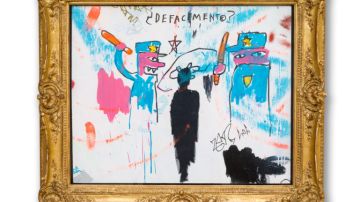Guggenheim’s Latest Exhibit Centers Afro-Latinx Artist Jean-Michel Basquiat’s ‘Defacement’
Thirty years after the death of Jean-Michel Basquiat, the Brooklyn-born artist’s most personal work is being exhibited at The Guggenheim Museum on the Upper East Side of New York City

Photo: Jean-Michel Basquiat Defacement (The Death of Michael Stewart) 1983 via Solomon R. Guggenheim Museum
Thirty years after the death of Jean-Michel Basquiat, the Brooklyn-born artist’s most personal work is being exhibited at The Guggenheim Museum on the Upper East Side of New York City. The exhibition, Basquiat’s “Defacement”’: The Untold Story, centers his 1983 work The Death of Michael Stewart, commonly referred to as Defacement, which addresses the death of fellow young, Black artist Michael Jerome Stewart at the hands of the New York City Transit Police.
Though accused of tagging the 14th Street station where he waited for his Brooklyn-bound L train around 2 am on September 15, 1983, the events that transpired between the subway station and Bellevue Hospital where Stewart arrived unconscious and in police custody, aren’t entirely clear. The 25-year-old artist was pronounced dead on September 28, sending a painful ripple effect throughout the art community — igniting protest art, protests and public outcry over Stewart’s fatal encounter with the police. His death impacted Basquiat greatly, as evident in several of his works thereafter.
Curated by Basquiat scholar and writer Chaédria LaBouvier, the thematic exhibition examines state violence, more specifically police brutality, as well as identity and activism through Basquiat’s eyes in the early ‘80s. In addition to Basquiat’s work, museum-goers see the work of Stewart, Keith Haring, Lyle Ashton Harris, George Condo, and Andy Warhol, among others. Protest flyers and newspaper clippings from the East Village Eye capture the reaction to Stewart’s death, the search for answers, and how friends and community leaders honored his spirit and pushed for justice.

“I want people to know that Michael Stewart was a human being, he wasn’t just his death,” LaBouvier tells me the day before the exhibition’s public debut.
It’s a first for several pieces from Stewart’s early work, and Basquiat’s first exhibition in 27 years at a large-scale NYC institution.
“In the nearly 31 years after his death, Basquiat has become one of the planet’s most popular, beloved artists. In a career that has spanned eight years, and nearly 2,000 works, Basquiat created and employed a visual language and iconography that has had a profound impact on popular culture and art history,” said LaBouvier, the Guggenheim’s first Black solo curator, in her welcome speech. “A closer look at Defacement offers an intimate look at his internal typography, particularly the fields and filters through which he addressed and explored trauma and the vicissitudes of history.”
Of the 15 works exhibited, LaBouvier notes Defacement is a stand out not just for its message, but the technique Basquiat uses. “It is devoid of the usual motifs of the sharply pointed crowns…and other signifiers of Black achievement that Basquiat employs to address the traumas of racism, slavery, Jim Crow, failed and successful revolutions, and colonialism,” she says.
Approximately the same size as Leonardo da Vinci’s Mona Lisa, Defacement pictures a Black figure centered and a cop on each side, described as “wolf-pig hybrids with fanglike teeth and pink flesh” (a nod to Black Panther artist Emory Douglas), holding their batons up as if ready to strike down at any moment. The painting conveys the power-dynamic between Black bodies and police. While the figure is meant to be Stewart, it could very well be Basquiat or any Black person. The ambiguity was intentional. It signals the fragility and disregard for Black lives in the presence of the authorities. Originally painted on Basquiat’s close friend Haring’s studio wall and later removed; a gilded frame was added to it once it was cut out of the wall and positioned above Haring’s bed until his death in 1990.

Also on display, Irony of a Negro Policeman (1981) and La Hara (1981) joining Defacement as a trilogy, according to LaBouvier. “The menacing hostility and escalating immediacy of all three works, coupled with their depictions or insinuations of racialized police engagement, constitute a trilogy of paintings that dialogue in an emotionally sequential and prophetic narrative that exists uniquely within Basquiat’s oeuvre-within-an-oeuvre of police works,” writes LaBouvier in “Defacement: Moment, History And Memory.”
An Afro-Latinx man living in New York, Basquiat was no stranger to violence from the state. He is digested as many things, depending on the viewer. However, he unapologetically identified as a Black man and, ultimately, his work viewed as African-American art. Though Afro-Latinx, his ethnicity is virtually erased as noted in “America’s Most Expensive Artist Is Latinx — but No One Knows It” by Dominican-American art history scholar Naiomy Guerrero. Being of Puerto Rican and Haitian descent, Basquiat’s cultural lineage does play a role in his art. La Hara, the misspelled version of the NuYorican term for police, can be viewed as an attempt to showcase the authorities via his Afro-Latinx perspective. Another piece, Untitled (1987), is thought to be a response to the August 1987 killing of Brazilian actor Fernando Ramos da Silva at the hands of São Paulo police, showcasing an Afro-Diasporic connection to history and events.
“There’s a lot of space to kind of sparse out where his identity was, but then also why his subject matter is so solidly African American? He understands, he has an encyclopedic knowledge of Black history” LaBouvier shares with me. “It’s not as though he doesn’t know, we have to give him credit for his agency and what he chose and what he identified with or as.”
Despite how he’s packaged or the many ways his artwork is received, Basquiat used his talent to create art that centered Blackness and called attention to history and then present-day issues. Many of which Defacement brings up, still are of great concern today.
Basquiat’s Defacement: The Untold Story is on view at The Guggenheim from June 21 through November 6, 2019.

















